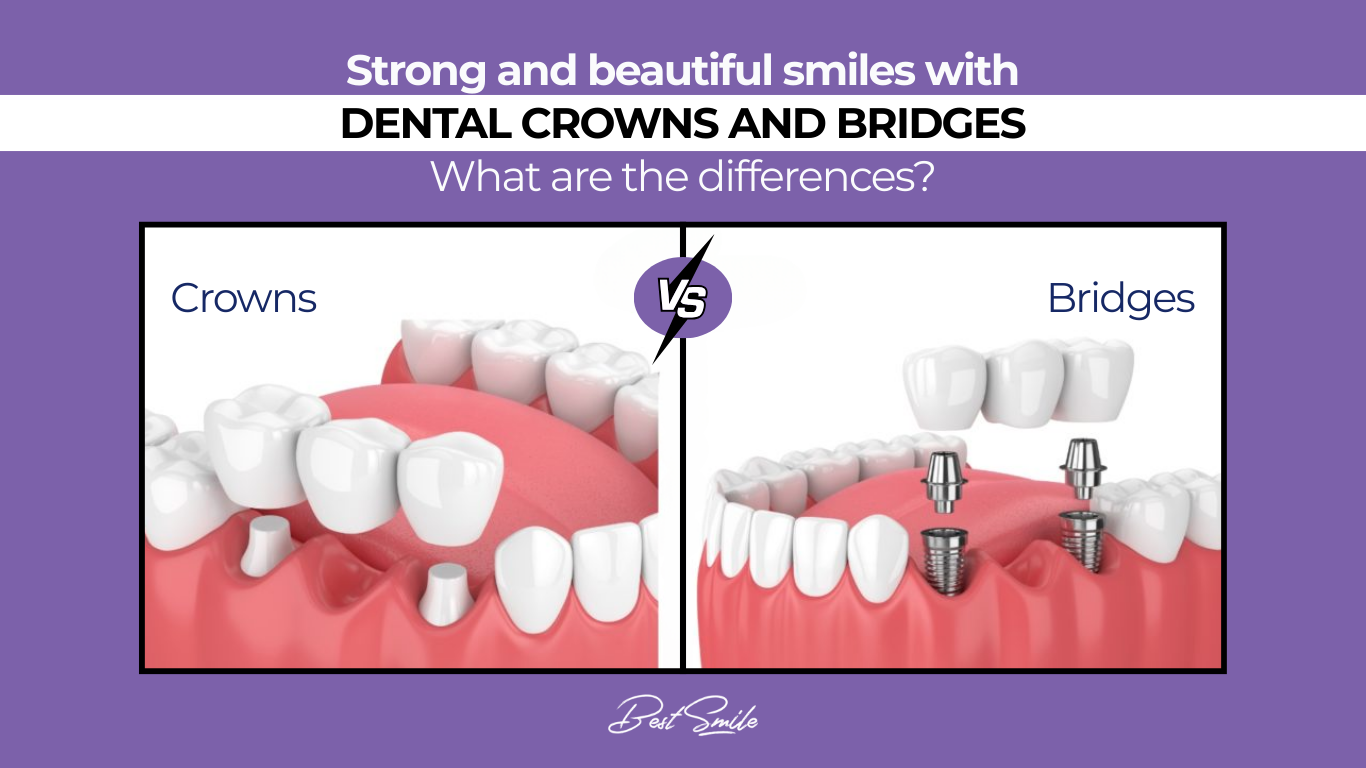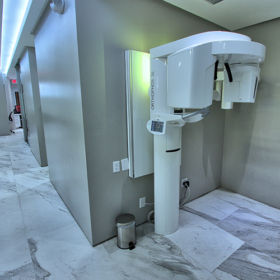If you’ve had a damaged or missing tooth, you’ve likely heard of dental crowns and bridges. Both treatments are effective solutions for restoring the functionality of your smile and preventing future complications. However, while both aim to improve the aesthetics and functionality of teeth, there are key differences between them. In this article, we’ll explain what dental crowns and bridges are, their differences, and how they can benefit you.
What Are Dental Crowns?
Dental crowns are restorations that completely cover a damaged or weakened tooth. Imagine a tooth that has deep decay, a fracture, or significant damage, making it vulnerable. In these cases, a crown is the ideal solution. It acts as a “shell” that covers the affected tooth, helping restore its size, shape, and function.
Crowns can be made from various materials, including:
-
Porcelain: This is an aesthetically pleasing material often used for visible teeth, as it mimics the color and appearance of natural teeth.
-
Metal: Metal crowns, such as those made from gold, are extremely durable and resistant, but are usually used for back teeth that are not visible.
-
Porcelain-fused-to-metal: This option offers an excellent combination of durability and aesthetics, as the metal provides strength, while the porcelain mimics the color of a natural tooth.
The process for placing a crown typically involves two visits to the dentist. During the first visit, the affected tooth is prepared, and an impression is taken to make the custom crown. During the second visit, the final crown is placed.
What Are Dental Bridges?
A dental bridge is a solution for replacing one or more missing teeth. This treatment bridges the gap left by missing teeth by using a series of crowns that are anchored to adjacent teeth. The natural teeth next to the gap act as supports to hold the bridge in place.
Bridges are composed of:
-
Anchor teeth: These are the natural teeth that are prepared to support the bridge.
-
Pontic: This is the false tooth that fills the gap left by the missing tooth.
-
Crowns: These are placed over the anchor teeth to secure the bridge in place.
The process for placing a bridge is similar to that of a crown. Two visits to the dentist are typically required: during the first visit, the anchor teeth are prepared, and an impression is taken, and during the second visit, the final bridge is placed.
Main Differences Between Crowns and Bridges
Although both crowns and bridges are used to restore damaged or missing teeth, there are some fundamental differences:
-
Purpose:
-
Dental Crown: Used to restore a single damaged or weakened tooth.
-
Dental Bridge: Used to replace one or more missing teeth.
-
-
Number of Affected Teeth:
-
Dental Crown: Only affects a single tooth, covering it entirely.
-
Dental Bridge: Involves multiple teeth, as it requires adjacent teeth to anchor the bridge.
-
-
Placement Process:
-
Dental Crown: Only one affected tooth needs to be prepared, and a single restoration is placed.
-
Dental Bridge: Involves preparing two or more anchor teeth and replacing one or more missing teeth with a pontic.
-
-
Durability:
-
Both solutions are durable, but bridges may be more susceptible to wear and may require adjustments over time due to the use of anchor teeth that can weaken over time.
-
When Is a Dental Bridge Needed?
A dental bridge is the best option when you have one or more missing teeth. Missing teeth not only affect your appearance but can also cause bite problems and shifting of the remaining teeth. A bridge not only helps restore the appearance of your smile but also prevents these issues, allowing for better chewing and proper tooth alignment.
Which Treatment Is Best for Me?
The decision to opt for a crown or a bridge depends on your specific situation. If you have a damaged but still viable tooth, a crown is likely the best option. However, if you’ve lost one or more teeth, a bridge might be the ideal solution. At Best Smile Cosmetic Dentistry, we offer a thorough evaluation to determine which treatment is best suited to your needs and goals.
Benefits of Dental Crowns and Bridges
-
Improved Aesthetics: Both treatments restore the natural appearance of your smile, especially when porcelain materials are used.
-
Restored Chewing Function: These treatments will allow you to chew and speak comfortably, improving your quality of life.
-
Prevention of Additional Issues: A bridge can prevent adjacent teeth from shifting and causing bite or alignment problems.
-
Durability: With proper care, both crowns and bridges can last many years, providing you with a long-lasting, functional smile.
FAQs about Dental Crowns and Bridges
-
Do crowns and bridges look natural?Yes, porcelain crowns and bridges are designed to mimic the appearance of natural teeth, providing an aesthetically pleasing smile.
-
Are the crown and bridge procedures painful?No, both treatments are performed with local anesthesia, so you won’t feel any pain during the procedure. Afterward, you may experience mild temporary sensitivity.
-
What care is needed after a crown or bridge procedure?It’s important to maintain good oral hygiene. Brushing twice a day and flossing will prevent issues with the anchor teeth or beneath the restoration.
-
How long do crowns and bridges last?With proper care, crowns and bridges can last between 10 to 15 years or more.
-
Are crowns and bridges covered by my dental insurance?Coverage depends on the type of dental insurance you have. We recommend reviewing your insurance plan to understand the specific coverage for these treatments.
If you’re considering a crown or bridge treatment, Best Smile Cosmetic Dentistry is here to help. Call us at (954) 248-2601 or (954) 431-8484 to schedule your appointment and get a personalized consultation. We’ll help you achieve the smile you’ve always dreamed of!












